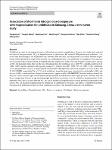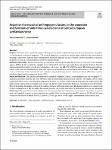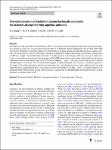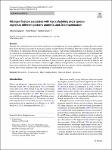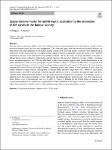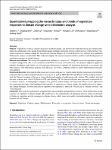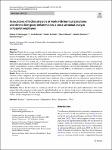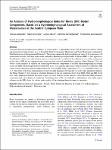Search
Author
- Osman, Ahmed I. (5)
- Chen, Zhonghao (2)
- Ricohermoso III, Emmanuel (2)
- Wang, Yongbin (2)
- next >
Subject
- LCA (6)
- ICP-MS (3)
- Artificial intelligence (2)
- CDW (2)
- next >
Date issued
Has File(s)
- true (220)
Search Results
Urolithiasis accounts for the highest incidence of all urologic-associated hospitalizations. However, few studies have explored the effect of nitrogen dioxide (NO2) on hospitalizations for urolithiasis. We included 5956 patients with urolithiasis, collected daily meteorological and air pollution data between 2016 and 2021, and analyzed the associations between air pollutants and hospitalization, length of the hospital stay, and hospitalization costs attributable to urolithiasis. NO2 exposure was associated with an increased risk of hospitalization for urinary tract stones. For each 10-μg/m3 increase and 1-day lag of NO2, the maximum daily effect on the risk of hospitalization for urolithiasis was 1.020 (95% confidence interval [CI]: 1.001–1.039), and the cumulative effect peaked on ... |
The study aims to assess the impact of human activity on the content and migration of trace elements in soil profiles of various physico-chemical properties. The research hypothesis assumed that human impact related to the functioning of buildings, agriculture, industry and communication negatively affected the trace element contents and physico-chemical properties of soils in a selected urban area (the Grudziądz Basin). |
In the present study, thermally treated kaolinite at 600 ºC was incorporated with titanium hydroxide produced from ilmenite to prepare a novel, low-cost and a promising adsorbent (KT). Different analytical techniques such as FTIR, EDS, SEM were used to determine its structural analysis. Its applicability for uranium uptaking and desorption from its aqueous solutions was investigated by varying controlling conditions including pH, shaking time, initial concentrations, temperature and KT dose weight. Untreated kaolinite showed zero loading capacity and adsorption efficiency towards uranium ions, on the contrary thermal activation and incorporation with Ti(OH)4 improved its performance. Batch results for adsorption experiments showed that loading capacity of (KT) reached 160mgg−1; at p... |
Nitrogen (N2) fixation by moss-associated cyanobacteria is an important N source in pristine ecosystems. Previous studies have shown that moss-associated N2 fixation is sensitive to anthropogenic N pollution. However, we still lack understanding of the effects of other factors derived from anthropogenic sources, such as heavy metal pollution on N2 fixation. To test this, we collected two dominant mosses (Pleurozium schreberi and Spaghnum palustre) from a temperate bog in Denmark and assessed their N2 fixation responses to simulated heavy metal pollution by adding 5 levels (plus a control) of copper (Cu, 0–0.05 mg g dw−1) and zinc (Zn, 0–0.1 mg g dw−1). Metal concentrations in both mosses increased linearly with Cu and Zn addition, but N2 fixation activity associated with S. palustre... |
Access to drinkable water is becoming more and more challenging due to worldwide pollution and the cost of water treatments. Water and wastewater treatment by adsorption on solid materials is usually cheap and effective in removing contaminants, yet classical adsorbents are not sustainable because they are derived from fossil fuels, and they can induce secondary pollution. Therefore, biological sorbents made of modern biomass are increasingly studied as promising alternatives. Indeed, such biosorbents utilize biological waste that would otherwise pollute water systems, and they promote the circular economy. Here we review biosorbents, magnetic sorbents, and other cost-effective sorbents with emphasis on preparation methods, adsorbents types, adsorption mechanisms, and regeneration o... |
Intensity-duration-frequency (IDF) curves are commonly used in engineering practice for the hydraulic design of flood protection infrastructures and flood risk management. IDF curves are simple functions between the rainfall intensity, the timescale at which the rainfall process is studied, and the return period. This work proposes and tests a new methodological framework for the spatial analysis of extreme rainfall depth at different timescales, taking advantage of two different precipitation datasets: local observational and gridded products. On the one hand, the proposed method overcomes or reduces known issues related to observational datasets (missing data and short temporal coverage, outliers, systematic biases and inhomogeneities, etc.). |
Vegetation is a typical sensitive indicator of climate change, and therefore provides theoretical and valuable information for addressing issues arising from climate change including improving soil ecosystem services. Exploring how vegetation responses to climate change has become one of major hotspots of research. However, few scholars have performed bibliometric analyses of this field. This study investigated the current research activities and the trend developments of vegetation responses to climate change. |
Despite the increasing scholarly interest in the phenomenon technostress, associated biological effects on employee health are under-researched. Chronic low-grade inflammation is suggested as a central pathway linking stress experience to disease development. The aim of this study was to assess associations of technology-related work stressors (technostressors) with low-grade inflammation and burnout symptoms. |
Recycling coal-based waste (CBW) into composites suitable as a building material might be a necessary response to combat its risk to the environment. Therefore, the objective of this study was to investigate the microstructure and performance of coal composites produced from CBW and polysiloxane polymer (SPR-212). Four types of CBW that differ in physicochemical properties were examined. Fourier transform infrared spectroscopy results indicated that the higher the intensity of the C=C bonds in the CBW, the higher the pyrolysis mass loss and shrinkage experienced by the composites during pyrolysis. The continuous operating temperature of the composites is up to 600 °C. However, at temperatures above 600 °C, composites containing carbon content greater than 36% manifested dramatic deg... |
Assessing the hydromorphological conditions of watercourses is a requirement of the Water Framework Directive (WFD) and national river status monitors (e.g., in Poland,the State Environmental Monitoring, and Water Monitoring coordinated by Chief Inspectorate of Environmental Protection). This paper evaluates the hydromorphological status of 10 watercourses (30 measurement sections) in Poland based on the multimetric Hydromorphological Index for Rivers (HIR). A new approach to the delineation of the river valley (small watercourses) is proposed. An analysis of the influence of river valley management on the value of HIR and its components was carried out using statistical methods (basic statistics, Mann–Whitney U Test and Ward’s cluster analysis). |

